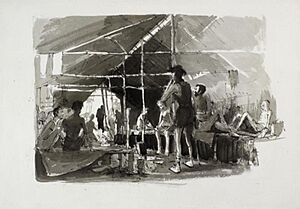Jack Bridger Chalker facts for kids
Quick facts for kids
Jack Bridger Chalker
|
|
|---|---|
| Born | 10 October 1918 |
| Died | 15 November 2014 (aged 96) |
| Nationality | British |
| Education | Goldsmiths College, Royal College of Art |
| Known for | Painting, drawing |
Jack Bridger Chalker (born October 10, 1918 – died November 15, 2014) was a British artist and teacher. He is famous for his drawings and paintings that show the lives of prisoners of war during World War II. These prisoners were forced to build the Burma Railway.
Jack Chalker's Life
Jack Chalker was born in London. His father was a railway stationmaster. Jack studied graphics and painting at Goldsmiths College. He then won a scholarship to the Royal College of Art in London. However, he joined the British Army before he could start his art scholarship.
War Experiences
In February 1942, Jack was serving in Singapore. He was a bombardier, which is a type of soldier who operates cannons. During the fall of Singapore, Japanese forces captured him. Jack became a prisoner of war.
He was held in different camps, including Changi prison. Later, he was sent to work on the Burma Railway. This railway was built by prisoners in very difficult conditions.
Art in Captivity
While working on the railway in Kanchanaburi, Jack secretly drew and painted. He used stolen paper and other materials. He wanted to record the tough conditions the prisoners faced. This included hunger, sickness, and harsh treatment.
It was very risky to do this. He could have been badly hurt if caught. But he managed to create over one hundred paintings and drawings. He kept them hidden from 1942 to 1945.
In 1944, he met an Australian surgeon named Colonel Edward Dunlop. Jack agreed to draw detailed pictures of the prisoners' health problems. This helped Dunlop with his medical work.
When the war ended in 1945, Jack was set free. He worked as an official war artist for a short time in Bangkok. Jack's artworks, along with those by other prisoner artists like Philip Meninsky and Ronald Searle, are very important. They show the suffering of prisoners building the railway. These artworks were even used as evidence in the Tokyo War Crimes Tribunal. This was a court that judged war crimes.
Many of Jack's paintings are now at the Australian War Memorial and the Imperial War Museum. In 1995, an exhibition showed the works of these artists. It was called 'The Major Arthur Moon Collection'.
After the War
Jack Chalker returned to England in late 1945. He finished his studies at the Royal College of Art in 1946. He became the Director of Art at the Cheltenham Ladies College. He also taught at the Cheltenham College of Printing.
In 1950, he became the Principal of Falmouth College of Art. Later, in 1958, he took the same job at the West of England College of Art in Bristol. When that college became part of Bristol Polytechnic in 1969, Jack became the Head of the Faculty of Art and Design. He stayed in that role until he retired in 1974.
Jack also worked as a medical illustrator. This means he drew pictures for medical books. He even made models of body parts for a medical company. He was given an honorary degree by the University of the West of England in 2003.
Because of his health problems from the war, Jack sold many of his Burma sketches in 2002. This auction got attention from all over the world.


